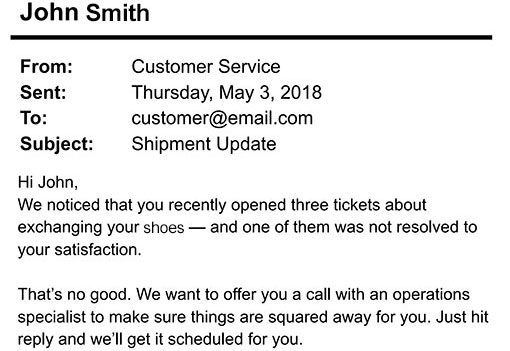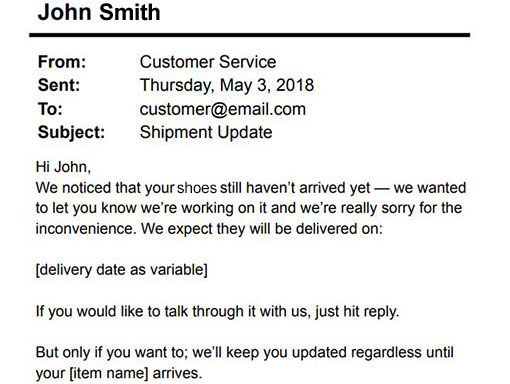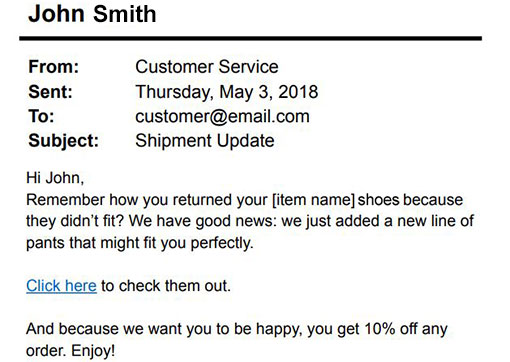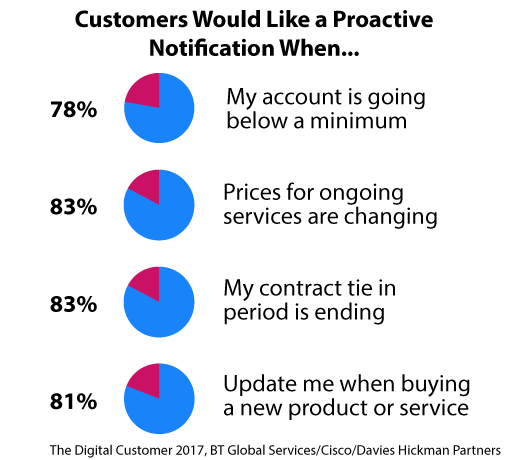Many companies are now focusing on getting the most out of customer data. This first led to personalising service and now to proactive service.
Why Is There a Focus on Proactive Customer Service?
Customer retention is one of the reasons why certain companies are choosing to put greater focus on proactivity. This is because organisations can use proactive messages to direct customers onto a “journey” that has the greatest levels of satisfaction.
These proactive messages can be used to save customers who are on the verge of leaving, while this approach can also help to minimise distractions during the customer’s experience. This can help to lower effort along the journey.
By lowering effort along the journey in this way, the organisation can simplify the customer experience, so customers don’t have to contact customer service later on. This is good practice because, as is often the case, the best service is no service.
Proactive customer service has been at the forefront of customer satisfaction for a while, as shown in a poll we ran 5 years ago, indicating that proactive Customer Service is the Key Strategy for Boosting Customer Satisfaction.
1. Follow Up Low Customer Satisfaction Survey Scores Immediately
Arguably, the most basic form of proactive customer service is to follow up low satisfaction scores immediately. This may be with an apology message, like the one below, or a follow-up phone call.

This message is an example of an automated message sent by a customer service tool. This tool is able to automate follow-ups across channels using tickets and Customer Satisfaction (CSat) results. It can also measure the effect of follow-ups on future tickets and satisfaction.
But remember, at the heart of this proactive approach is a sincere apology. So, before you focus on the logistics of sending out the message, make sure you’ve got the wording right.
Find out how to write a great customer service apology by reading our article: Customer Service Apologies – Keeping Sorry Fresh and Sincere
2. Engage With Customers Who Leave Great Feedback
Once a customer has left great customer feedback, you have an opportunity to boost sales through service with a well-timed promotional proactive message.
Seize your opportunity by sending the customer a message and, if possible, offer them some sort of discount. This helps turn a great customer experience into a memorable customer experience.
It is a shame when companies get great feedback and just leave it there. In time, customers will forget how great an experience was. So, occasional reminders – to high-CSat customers – may not go amiss.
3. Create New Rules Based on the Customer Journey
The next level of proactive customer service is all about anticipating customer needs and providing an answer, without advisor intervention, before a question is asked.
So, it’s time to create rules based on the customer journey for when is best to intervene. Look for moments, perhaps through mystery shopping and listening to customer/advisor feedback, when a “guiding message” could be used well.

Messages like the one above when a delivery is later than expected demonstrate how proactive messages can lower customer effort, if used at the right times. This example prevents customers from having to track their delivery, and find out the bad news for themselves.
But don’t boil the ocean when it comes to this stuff. Adding too many proactivity messages at once can change the journey at an unmanageable rate.
So, it might be best to make one change at a time and measure its impact.
4. Use Timely Pop-Ups or Web Widgets
Pop-up messages to offer customer support are not revolutionary, but more is being done to ensure that they are used proactively, to appear at the most valuable time for the customer.
A pop-up that appears too often can prove irritating, yet having the function there, to reassure customers and increase business, is advantageous. So, advanced companies are now using software to find the best times to do this.
Software tools can detect when a customer has a high-value basket and is taking a long time to check out. In this scenario, an organisation can time a proactive pop-up to answer any questions that the high-value customer may have.
For example, software tools can detect when a customer has a high-value basket and is taking a long time to check out. In this scenario, an organisation can time a proactive pop-up to answer any questions that the high-value customer may have – reassuring them of their decision, before they follow through on the purchase.
However, these customers may also want to interact with the company in other ways. So some organisations instead use web widgets, which are pop-ups that include options for self-service (i.e. FAQ searches), requesting a call-back and the conventional live chat.
5. Personalise the Website
It is old news that major companies present the content that is likely of most interest to the individual customer on the homepage of their website. Now, some companies are further personalising their websites and being proactive by using customer data and machine learning.
For example, some organisations adapt their website depending on the location of the customer. This is not only in terms of language, from country to country, but also in terms of the amount of information given with each product/service. So, a product may be given a longer description in Japan or South Korea than in the UK or US, for instance, as they value this more.
Also, by using AI, some companies are tracking where readers from different locations are moving their mouse (and therefore eyes) across the page. This gives companies the best idea of where to place their most valuable content.
6. Use AI to Grow and Retain
AI can be used analyse historical data and survey responses to determine when a customer is healthy, satisfied and ready to engage.
Through this use of AI, organisations are combining support history with product history to target offers and encourage engagement, depending on predictions of the customer’s ‘status’.
An example of a message of this kind is highlighted below.

By doing this, Jeff says that “contact centres can show the business value of their support interactions by tracking how growth metrics change when support intervenes.”
In theory, this should enable the organisation to retain customers and improve word of mouth.
7. Use Remote Asset Monitoring
Remote asset monitoring can track the condition of certain electronic products – such as washing machines, for example. This tracking can alert the contact centre when the product needs repairing or replacing.
Once the contact centre receives the alert, they can then send a proactive message to the customer.
While this may seem extreme, advanced organisations are constantly trying to think of new innovations revolving around proactivity, and most involve AI.
Using Amazon as an example, Martin Hill-Wilson, Founder of BrainFood Extra, said in our article “The New Rules of Customer Service” that: “Amazon would calculate the sum total of my insights – based on what I’ve bought, what I hovered over, what I’ve put into my wish list etc. – whereby they would know what I would buy from them next. This was to the extent where they would forward-ship that product to a local distribution point.”
The Two Mistakes Often Made With Proactive Service
Although proactive customer service is still in its infancy for most organisations, there are two mistakes that some brands have fallen into, as highlighted below.
1. Failing to Align Messaging Between Departments
Align the messaging of your contact centre with other departments in the organisation, like marketing, accounts and research.
Customers don’t like to be overloaded with information, so it’s important to align the messaging of your contact centre with other departments in the organisation, like marketing, accounts and research.
Why? Because if a customer has three pop-up emails on their phone from you in a week, for example, they will likely grow tired of your brand and send your messages to the spam folder. A vital “port” of contact is then lost.
So, when creating a plan for proactive customer service, include other departments – especially marketing, with whom the contact centre should already have close links.
These close links help to make sure the service delivered to customers is in line with their expectations, which largely come from marketing material.
2. Sending Promotional Content to Low-Satisfaction Customers
Proactive messaging should be used as a tool to save customers, not push them “over the edge”. Yet this is what could happen if you send the wrong messaging to dissatisfied customers.
For example, if a customer has just made a complaint about the low quality of a product, don’t send them a promotional offer for that product. You may as well send them an advert for one of your competitors.
So, have a category for dissatisfied customers within your messaging system. This category can then be excluded from any promotional mailings.
Are Customers Ready for Proactive Customer Service?
Many customer experience teams will soon question whether they need to start to figuring out what the customer wants before the customer knows they want it. The problem is – according to Nicola Millard, Head of Customer Insights and Futures at BT – “that this sometimes crosses the creepy line.”
“The first step is personalisation and we are perfectly comfortable with that. This what Amazon and Netflix do on a daily basis – personalising the interface, based on what we have told them.”
“The next step is to look at customer data and assess whether there is something that we need to tell the customer before the customer needs to tell us. This involves looking at the customer’s channel preferences and finding their preferred channel for proactivity.”
This step includes sending little reminders that customers actually want to know. According to BT research, as highlighted below, most customers approve of this kind of proactive service.

As Nicola says: “Generally, we will share things like social media data and our personal data, as long as there is an advantage in there for us.”
The problem then is when we use machine learning to become too predictive, to the extent where we can start to figure out what the customer wants before the customer knows they want it. This is where it can, for the moment, get a little creepy.

Nicola Millard
Nicola continues: “A well-known supermarket in the UK has a lot of data and one of their analysts was telling me they can tell if you’re about to get divorced (i.e. stop doing business with the company).”
“Now, would I then send an email out to somebody to say I’m really sorry to see you go – probably not. Maybe vouchers for wine or something would be more appropriate in this instance.”
“So, there needs to be a human to figure out what is appropriate, at this stage, because if it gets too creepy, the customer may choose to withdraw their data.”
This may certainly be the case in Europe, in this new era of GDPR, where we – as customers – can choose to say ‘no, I don’t want to share my data with you’.
Yet, this level of proactivity hinges on data, so how do we trade data is becoming increasingly important, at a time when some companies are even using remote asset monitoring for proactive service (point 7).
For another great article about Proactive Customer Service, with examples, see our article What Is Proactive Customer Service? With a Definition, Examples and Key Challenges
Author: Robyn Coppell
Published On: 8th Aug 2018 - Last modified: 14th Aug 2025
Read more about - Customer Service Strategy, Artificial Intelligence (AI), Customer Service, Editor's Picks, Martin Hill-Wilson, Nicola Millard, Service Strategy











































